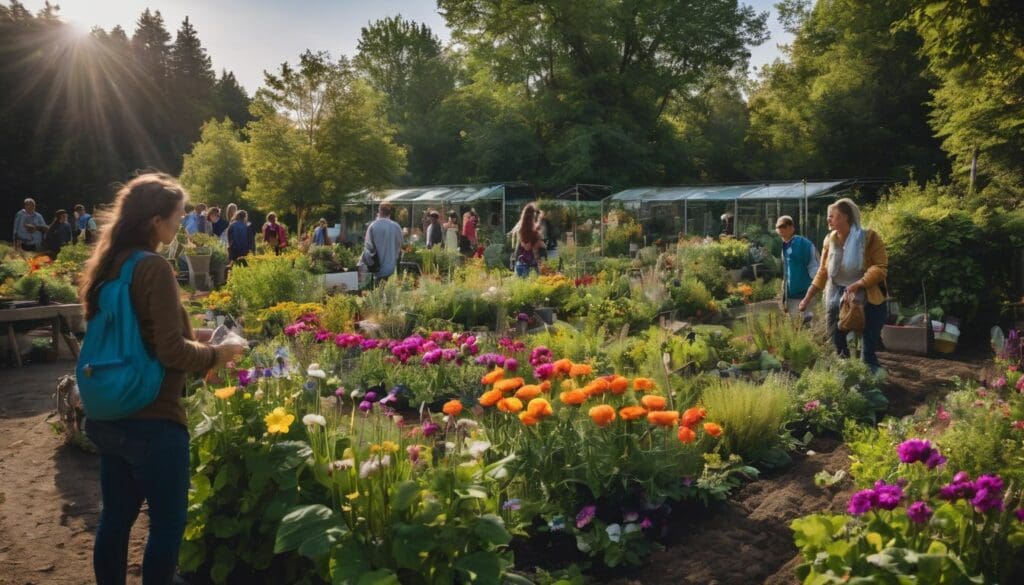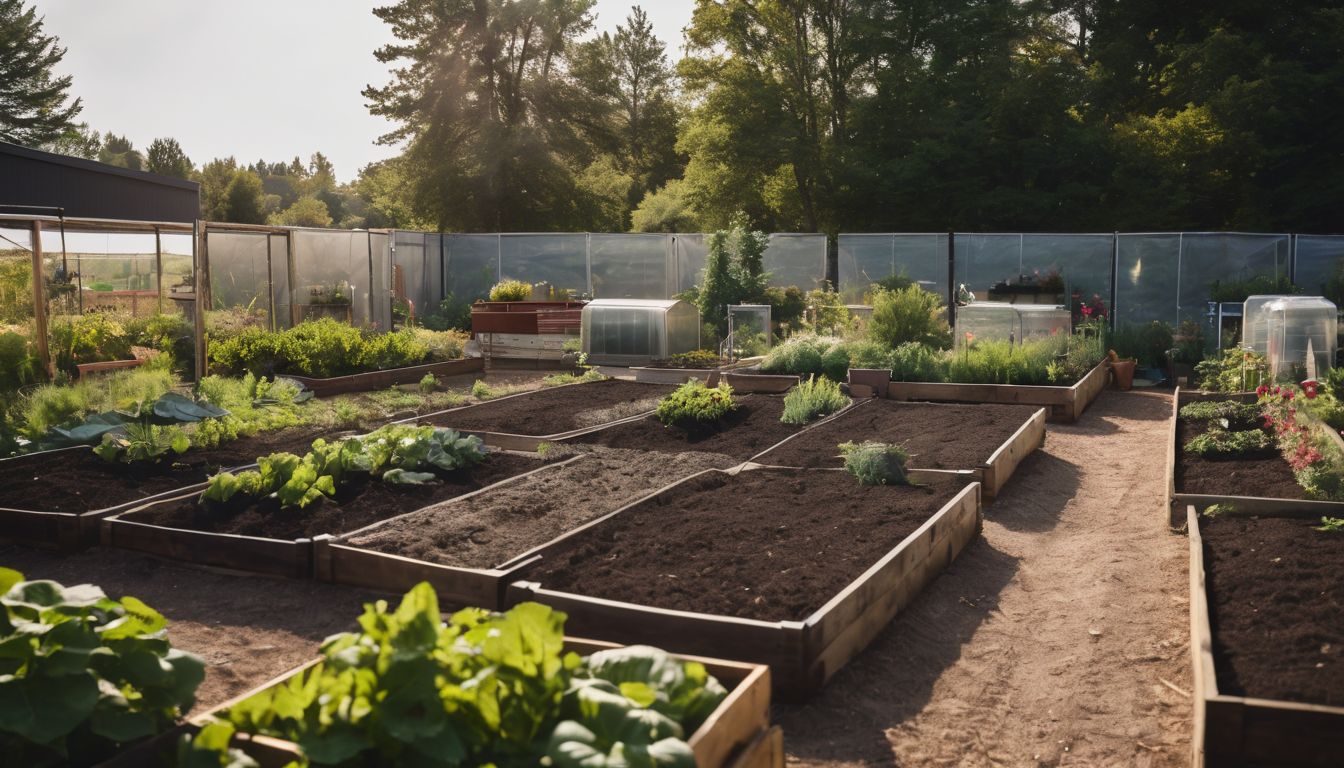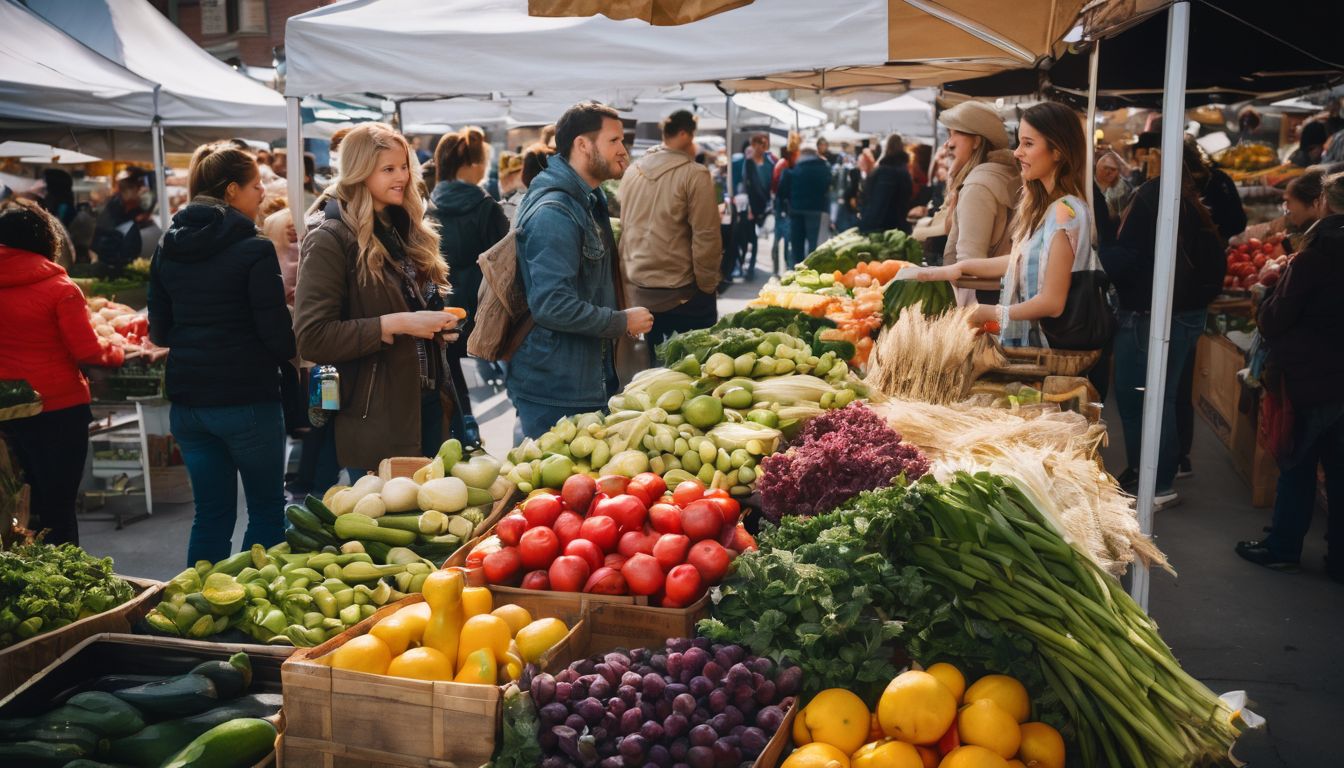Gardening space is an absolute gem in our bustling urban jungles, and we’re all too familiar with the challenge of squeezing your horticultural dreams into the tiniest of corners. It’s a tale as old as time for city dwellers hungry for a slice of greenery.
That’s why we’ve embraced community gardens, little oases that can turn underloved swathes into thriving spots brimming with life and local camaraderie. Our guide is on hand to lead you through conjuring up one from the ground up, illustrating that it’s entirely feasible to cultivate not only delightful flora but also strengthen bonds within the neighbourhood fabric.
So pop on those gloves—it’s time to get started!
Key Takeaways
- Starting a community garden enriches neighbourhoods by providing fresh produce, promoting sustainability, and fostering strong community bonds.
- To establish a garden, form a committee, find land with good soil and sunlight, navigate legalities like permissions and insurance, then plan the budget before planting begins.
- Essential elements of a successful garden include individual plots for members to cultivate personally chosen plants along with communal areas for shared gardening efforts.
- Engaging locals through events and partnering with organisations multiplies benefits by enhancing education on sustainable living practices and addressing food insecurity within the area.
- Regular maintenance and an active approach to expanding the garden are key components in ensuring its continued growth as well as environmental contribution.
Why Start a Community Garden?
Starting a Community Garden offers numerous benefits to the community, such as promoting sustainable living and encouraging community involvement. It also provides a platform for local residents to grow their own fresh produce and fosters a sense of ownership and pride in the neighborhood.
Benefits for the community
Community gardens bloom with potential, transforming spaces and lives. They become hubs where sustainability meets fellowship, seeding growth beyond the garden beds.
- They foster environmental stewardship, encouraging participants to engage in practices that protect and enhance our surroundings.
- Our efforts in local food production reduce carbon footprints by decreasing the need for transportation of produce from far away.
- Gardens serve as vibrant green lungs in urban settings, purifying air and providing a sanctuary for local wildlife.
- Engaged neighbours strengthen community bonds, breaking down barriers as they work side by side in the soil.
- Initiatives like these often revitalise neglected areas, turning vacant lots into productive and beautiful spaces.
- Urban agriculture educates both young and old about the origins of their food and the importance of nutrition.
- A community garden offers opportunities for hands – on learning, from permaculture techniques to organic gardening methods.
- We promote food security by providing fresh produce to those involved, especially benefiting those without access to garden space at home.
- Group gardening encourages an active lifestyle, with physical exercise naturally built into gardening tasks.
Encouraging sustainable living
To encourage sustainable living, we prioritise organic gardening methods and promote the use of composting to reduce waste and support healthy soil development. We also advocate for water conservation techniques such as drip irrigation systems and rainwater harvesting, reducing our environmental impact and promoting responsible resource usage within our community garden.
By implementing these sustainable practices, we contribute to a healthier environment while setting an example for others in our neighbourhood.
Moving forward with developing the community garden, let’s consider the steps to establish it: assembling a gardening committee, determining suitable land for the garden, obtaining necessary permissions and insurance, planning and budgeting for the garden, then beginning growing and maintaining it.
Promoting community involvement
We organise community events like gardening workshops and volunteer days to encourage participation in our neighbourhood garden. Local businesses offer sponsorships, providing resources and expertise for our sustainable agriculture initiatives.
By engaging the community in regular meetings and updates, we foster a sense of ownership and pride in our shared green space. Our educational programmes promote food security and sustainable living practices, attracting diverse members to join our vibrant gardening committee.
To expand the reach of our project, we collaborate with local organisations for broader impact on neighbourhood revitalisation. We actively seek opportunities to involve residents through social media and outreach efforts, bringing individuals together around a common goal – creating a healthier, more connected community through urban planning centred on sustainable gardening.
Steps to Establish a Community Garden
To establish a community garden, start by assembling a gardening committee to plan and coordinate the project. Determine suitable land for the garden and obtain necessary permissions and insurance before planning and budgeting for the garden’s development.
Finally, begin growing and maintaining the garden once all preparations are in place.
Assemble a gardening committee
Let’s gather a diverse and passionate gardening committee to drive our community garden project. Engage enthusiastic members who bring various skills, experiences, and perspectives to the table.
Assign clear responsibilities and roles, ensuring everyone feels valued in contributing to this exciting initiative.
Seek out individuals with expertise in areas like landscaping, budgeting, community engagement, or event planning. Encourage participation from local residents, businesses, schools, and community organisations; their input can enrich the garden’s vision and expand its impact.
Determine suitable land for the garden
After assembling a gardening committee, the next step is to determine suitable land for the garden. Start by identifying vacant lots or underutilised spaces in your community. Look for areas with good sunlight exposure and access to water sources.
Consider reaching out to local authorities or landowners about potential sites for the garden. Evaluate the soil quality and drainage of each location to ensure it can support a thriving garden.
Engage with neighbours and community members to gather input on preferred locations that are easily accessible for all participants.
Obtain necessary permissions and insurance
To establish a community garden, we need to obtain necessary permissions and insurance for the project. Here are the steps you should follow:
- Research local regulations and zoning laws to understand what permits and permissions are required for establishing a community garden in your area.
- Contact local government authorities or relevant agencies to apply for the necessary permits. Ensure that you provide all required documentation and information.
- Consult with an insurance agent or broker to secure liability insurance for the community garden. This will protect the garden organisers and volunteers in case of accidents or damage on the premises.
- Consider forming a legal entity, such as a non-profit organisation, to manage the garden project and facilitate obtaining insurance.
Plan and budget for the garden
After obtaining necessary permissions and insurance, it’s essential to plan and budget for the garden. We need to allocate funds for tools, seeds, soil improvement materials, water access, and potential maintenance costs.
The planning committee must collaborate on a detailed layout design of the garden to estimate expenses accurately. By organising a community fundraising event or seeking local sponsorship, we can secure financial support for our gardening programme without putting excessive pressure on individual contributors.
Keeping track of expenditure through transparent financial reporting will ensure that our resources are managed efficiently.
Begin growing and maintaining the garden
After planning and budgeting for the garden, it’s time to roll up our sleeves and start growing. Regular maintenance is key to a flourishing community garden. Maintaining individual plots, communal areas, and the overall garden space ensures a healthy environment for all plants.
We’ll need to water regularly and keep an eye out for pests or disease, while also promoting sustainable practices like composting to enrich the soil. Active involvement in tending to the garden helps foster a sense of ownership among participants and encourages community collaboration.
Expanding our knowledge about vegetable gardening methods will help us yield abundant crops year after year. By sharing insights and learning from each other, we can build on our successes as we continue nurturing this invaluable resource.
Basic Elements of a Community Garden
-Individual plots for gardeners
-Communal gardening areas
-Water source and irrigation system
-Tool shed and storage space
-Composting area
Plots for individual gardeners
Individual gardeners can have their own designated plots within the community garden. Each gardener will be responsible for maintaining and cultivating their plot, allowing them to grow a variety of fruits, vegetables, herbs, or flowers based on personal preferences.
The allocation of individual plots promotes a sense of ownership and encourages active participation in the gardening process. This also provides an opportunity for members to experiment with different planting techniques, crop rotations, and organic growing methods while fostering a strong connection to the natural environment.
Gardeners should adhere to the agreed-upon guidelines related to plot size and maintenance standards to ensure fairness and the overall aesthetic appeal of the communal space. Every member’s distinct approach towards nurturing their respective gardens contributes to an enriching tapestry of biodiversity within the community garden.
Common areas for communal gardening
Communal gardens provide spaces for members of the community to come together, collaborate, and share in the joy of gardening. These shared areas often include flower beds, fruit trees, and communal vegetable plots where individuals can work collectively to grow produce for the entire community.
It’s also common to find seating areas or picnic spots within these communal spaces, creating a warm and inviting atmosphere that encourages social interaction while enjoying the beauty of nature.
In addition to fostering a sense of unity and shared responsibility among members, communal gardening areas serve as valuable educational resources where people can learn from each other and exchange knowledge about sustainable gardening practices.
This collaborative approach not only nurtures a strong sense of community but also promotes environmental awareness and conservation efforts. By investing in communal garden spaces, we are not only nurturing plants; we are cultivating connections with nature and each other.
Water source and irrigation system
Our community garden ensures a reliable water source and efficient irrigation system. We have installed rainwater harvesting tanks to collect and store rainwater for garden use, minimising our reliance on mains water supply.
Drip irrigation systems are in place for each plot, delivering precise amounts of water directly to the plant roots, conserving water and reducing waste. In addition, we encourage mulching around plants to retain soil moisture and reduce evaporation, further supporting sustainable practices.
To enhance our garden’s environmental impact positively, we continuously assess our watering methods using appropriate technology that aligns with conservation efforts. Our community understands the importance of responsible water usage in preserving the environment while promoting sustainable gardening practices for the benefit of all involved.
Tool shed and storage space
The tool shed holds all the essential gardening equipment. It also acts as a storage space for communal supplies and materials. We must ensure that it is well-organised and easily accessible to all members of the community garden.
The shed should also provide ample space to store tools, seeds, pots, and other gardening essentials securely.
Additionally, we need to consider implementing a sign-out system for the tools to ensure they are returned promptly. This will help maintain the shared resources efficiently while promoting responsible use among us.
Composting area
After ensuring adequate tool shed and storage space, the next essential element of a community garden is the composting area. Composting is an integral part of sustainable gardening as it reduces waste, enriches soil, and minimises the need for chemical fertilisers.
A well-designed composting area should be easily accessible and large enough to accommodate organic waste from both individual plots and communal areas. It’s crucial to educate gardeners on what types of materials can be composted and how to maintain the compost piles properly.
When planning a community garden, it’s vital to allocate sufficient space for the composting area, taking into consideration factors such as airflow control, drainage, and proximity to water sources.
Additional Considerations for a Successful Community Garden
– Hosting events and workshops to engage the community and promote volunteerism, partnering with local organisations and businesses for support, and maintaining and expanding the garden over time are all essential aspects of ensuring a successful community garden.
Hosting events and workshops
To engage the community and share knowledge about sustainable gardening practices, we organise various events and workshops throughout the year. These interactive sessions provide opportunities for individuals to learn about organic gardening techniques, composting methods, and water conservation strategies.
By hosting educational events and practical workshops, we aim to empower our community members with the skills needed to contribute actively towards environmental preservation and food security initiatives.
Moreover, these gatherings also serve as platforms for networking, fostering relationships among like-minded individuals who are passionate about urban gardening and community development.
Partnering with local organisations and businesses
As we aim to engage the community and promote volunteerism through hosting events and workshops, partnering with local organisations and businesses becomes crucial. Collaborating with nearby non-profits, schools, or companies can bring valuable resources, expertise, and support to our community garden project.
Local businesses may contribute supplies or funding, while organisations could offer educational programs or volunteer opportunities that enhance the garden’s impact in promoting sustainable living.
By working together with these entities, we can amplify our efforts towards supporting education and food security initiatives within our neighbourhood.
Engaging the community and promoting volunteerism
When partnering with local organisations and businesses to support your community garden, it is crucial to engage the community and promote volunteerism. Encouraging active involvement from residents not only fosters a sense of ownership but also creates a strong network of support for the garden’s sustainability.
Hosting regular events such as workshops or gardening classes can attract individuals interested in participating or learning more about sustainable practices.
By creating opportunities for volunteer work within the garden, you can inspire individuals to contribute their time and skills towards its maintenance and growth. This collaborative effort not only enhances the productivity of the garden but also strengthens communal bonds, promoting a shared commitment to environmental stewardship.
Supporting education and food security initiatives
Engaging the community and promoting volunteerism lays a solid foundation for supporting education and food security initiatives within the community garden. By partnering with local schools, educational institutions, and community organisations, we can create opportunities for learning about sustainable agriculture, nutrition, and environmental stewardship.
Hosting workshops on gardening techniques and healthy eating habits can empower individuals to make informed choices about their food consumption while fostering a sense of communal growth.
Additionally, by donating surplus produce to local food banks or collaborating with organisations focused on addressing food insecurity, our community garden can play an active role in providing fresh, nutritious options for those in need.
Maintaining and expanding the garden over time
To maintain and expand the garden over time, we regularly schedule community workdays for ongoing upkeep and expansion projects. We encourage members to volunteer their time each month to tend to communal areas, replenish mulch, weed gardens, and engage in seasonal planting.
By hosting regular events such as plant swaps and gardening workshops, we share knowledge amongst the community while attracting new members interested in sustainable living and growing their own produce.
Additionally, partnerships with local schools nurture future generations of gardeners by offering educational programs about food security and environmental stewardship.
Conclusion
In conclusion, starting a community garden offers numerous benefits for the neighbourhood. Encouraging sustainable living and promoting community involvement are key motivators. By following the steps outlined in this guide and considering additional elements for success, you can create a vibrant hub of greenery and camaraderie in your area.
Establishing and maintaining a community garden requires dedication but promises to be an immensely rewarding endeavour. Get ready to witness a positive impact on the environment and foster strong connections within your local community!
FAQs
1. How do I start planning a community garden?
Begin by organising a committee within your neighbourhood to discuss garden project planning and design the layout of the community garden.
2. What’s the first step in creating a community garden?
The first step is gathering interested neighbours to form an organisation and finding a suitable vacant lot for the community gardening project.
3. Can anyone join in on starting a community garden?
Absolutely! Community gardens thrive on neighbourhood involvement, so everyone interested should be encouraged to participate in organising and planning.
4. Are there special rules for using land for a community garden?
It’s crucial to get permission to utilise any vacant lot for gardening purposes and ensure all local regulations are followed during the process.





